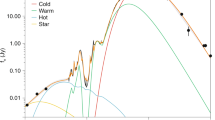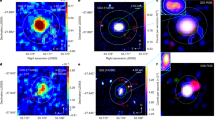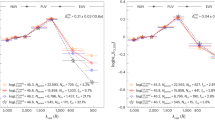Abstract
The spectrum of any star viewed through a sufficient quantity of diffuse interstellar material reveals a number of absorption features collectively called ‘diffuse interstellar bands’ (DIBs). The first DIBs were reported about 90 years ago1, and currently well over 500 are known2. None of them has been convincingly identified with any specific element or molecule, although recent studies suggest that the DIB carriers are polyatomic molecules containing carbon3,4,5. Most of the DIBs currently known are at visible and very near-infrared wavelengths, with only two previously known at wavelengths beyond one micrometre (10,000 ångströms), the longer of which is at 1.318 micrometres (ref. 6). Here we report 13 diffuse interstellar bands in the 1.5–1.8 micrometre interval on high-extinction sightlines towards stars in the Galactic Centre. We argue that they originate almost entirely in the Galactic Centre region, a considerably warmer and harsher environment than where DIBs have been observed previously. The relative strengths of these DIBs towards the Galactic Centre and the Cygnus OB2 diffuse cloud are consistent with their strengths scaling mainly with the extinction by diffuse material.
This is a preview of subscription content, access via your institution
Access options
Subscribe to this journal
Receive 51 print issues and online access
$199.00 per year
only $3.90 per issue
Buy this article
- Purchase on Springer Link
- Instant access to full article PDF
Prices may be subject to local taxes which are calculated during checkout



Similar content being viewed by others
References
Heger, M. L. The spectra of certain class B stars in the regions 5630–6680 Å and 3280–3380 Å. Lick Obs. Bull. 10, 146–147 (1922)
DIB database . 〈http://dibdata.org〉 (July 2011)
Cox, N. L. J. in PAHs and the Universe: A Symposium to Celebrate the 25th Anniversary of the PAH Hypothesis (eds Joblin, C. & Tielens, A. G. G. M. ) 349–354 (EAS Publication Series Vol. 46, European Astronomical Society, 2011)
Snow, T. P. & McCall, B. J. Diffuse atomic and molecular clouds. Annu. Rev. Astron. Astrophys. 44, 367–414 (2006)
Oka, T. & McCall, B. J. Disclosing identities in diffuse interstellar bands. Science 331, 293–294 (2011)
Joblin, C., Maillard, J. P., D’Hendecourt, L. & Léger, A. Detection of diffuse interstellar bands in the infrared. Nature 346, 729–731 (1990)
Nagata, T., Woodward, C. E., Shure, M., Pipher, J. L. & Okuda, H. AFGL 2004: an infrared quintuplet near the Galactic Center. Astrophys. J. 351, 83–88 (1990)
Muno, M. P. et al. Isolated massive supergiants near the Galactic Center. Astrophys. J. 638, 183–190 (2006)
Figer, D. F., McLean, I. S. & Morris, M. Massive stars in the Quintuplet Cluster. Astrophys. J. 514, 202–220 (1999)
Humphreys, R. M. Studies of luminous stars in nearby galaxies. I. Supergiants and O stars in the Milky Way. Astrophys. J. 38, 309–350 (1978)
Bromage, G. E. & Nandy, K. Observations of diffuse interstellar features in the spectra of dust-embedded and field stars. Astron. Astrophys. 26, 17–32 (1973)
Rawlings, M., Adamson, A., McCall, B. & Kerr, T. A high-resolution study of the near-infrared diffuse interstellar bands. Presented at IAU Symp. No. 280 〈http://adsabs.harvard.edu/abs/2011IAUS..280P.311R〉 (2011)
Whittet, D. C. B. et al. Infrared spectroscopy of dust in the diffuse interstellar medium toward Cygnus OB2 no. 12. Astrophys. J. 490, 729–734 (1997)
Oka, T., Geballe, T. R., Goto, M., Usuda, T. & McCall, B. J. Hot and diffuse clouds near the Galactic Center probed by metastable H3+. Astrophys. J. 632, 882–893 (2005)
Goto, M. et al. Absorption line survey of H3+ toward the Galactic Center sources. II. Eight infrared sources within 30 pc of the Galactic Center. Astrophys. J. 688, 306–319 (2008)
Hobbs, L. M. et al. Studies of the diffuse interstellar bands. III. HD 183143. Astrophys. J. 705, 32–45 (2009)
Indriolo, N., Geballe, T. R., Takeshi, O. & McCall, B. J. H3+ in diffuse interstellar clouds: a tracer for the cosmic-ray ionization rate. Astrophys. J. 671, 1736–1747 (2007)
Draine, B. T. Physics of the Interstellar and Intergalactic Medium (Princeton Univ. Press, 2011)
Herbig, G. H. The diffuse interstellar bands. Annu. Rev. Astron. Astrophys. 33, 19–73 (1995)
Pendleton, Y. J., Sandford, S. A., Allamandola, L. J., Tielens, A. G. G. M. & Sellgren, K. Near-infrared absorption spectroscopy of interstellar hydrocarbon grains. Astrophys. J. 437, 683–696 (1994)
Rawlings, M. G., Adamson, A. J. & Whittet, D. C. B. Infrared and visual interstellar absorption features toward heavily reddened field stars. Mon. Not. R. Astron. Soc. 341, 1121–1140 (2003)
Acknowledgements
This Letter is based on observations obtained at the Gemini Observatory, which is operated by the Association of Universities for Research in Astronomy, Inc., under a cooperative agreement with the NSF on behalf of the Gemini partnership: the National Science Foundation (US), the Science and Technology Facilities Council (UK), the National Research Council (Canada), CONICYT (Chile), the Australian Research Council (Australia), Ministério da Ciência e Tecnologia (Brazil) and Ministerio de Ciencia, Tecnología e Innovación Productiva (Argentina). This work was supported by the Spanish Ministerio de Ciencia e Innovación. We thank A. Lenorzer for reductions of the H-band spectra of the Cygnus OB2 stars, and B. J. McCall and T. Oka for reviewing a preliminary version of the manuscript.
Author information
Authors and Affiliations
Contributions
T.R.G. and F.N. wrote the observing proposal. T.R.G. obtained the data. B.W.S. and T.R.G. reduced the data. F.N. and T.R.G. recognized the spectral features as DIBs. T.R.G., F.N., D.F.F., D.F. and B.W.S. discussed the results. T.R.G., F.N. and D.F.F. wrote the Letter.
Corresponding author
Ethics declarations
Competing interests
The authors declare no competing financial interests.
Rights and permissions
About this article
Cite this article
Geballe, T., Najarro, F., Figer, D. et al. Infrared diffuse interstellar bands in the Galactic Centre region. Nature 479, 200–202 (2011). https://doi.org/10.1038/nature10527
Received:
Accepted:
Published:
Issue Date:
DOI: https://doi.org/10.1038/nature10527
This article is cited by
Comments
By submitting a comment you agree to abide by our Terms and Community Guidelines. If you find something abusive or that does not comply with our terms or guidelines please flag it as inappropriate.



